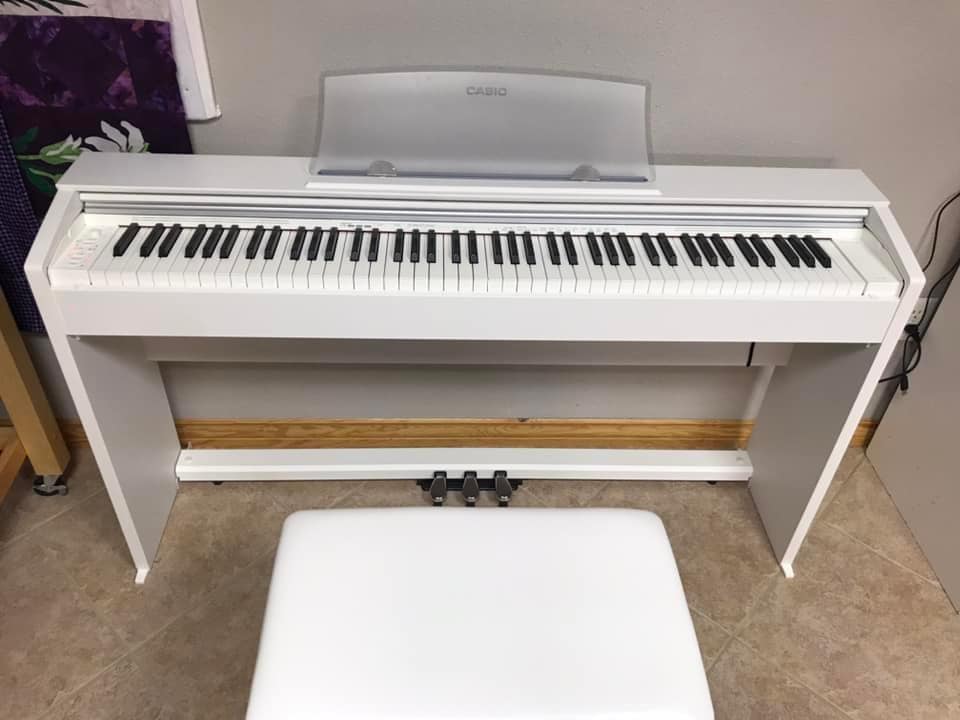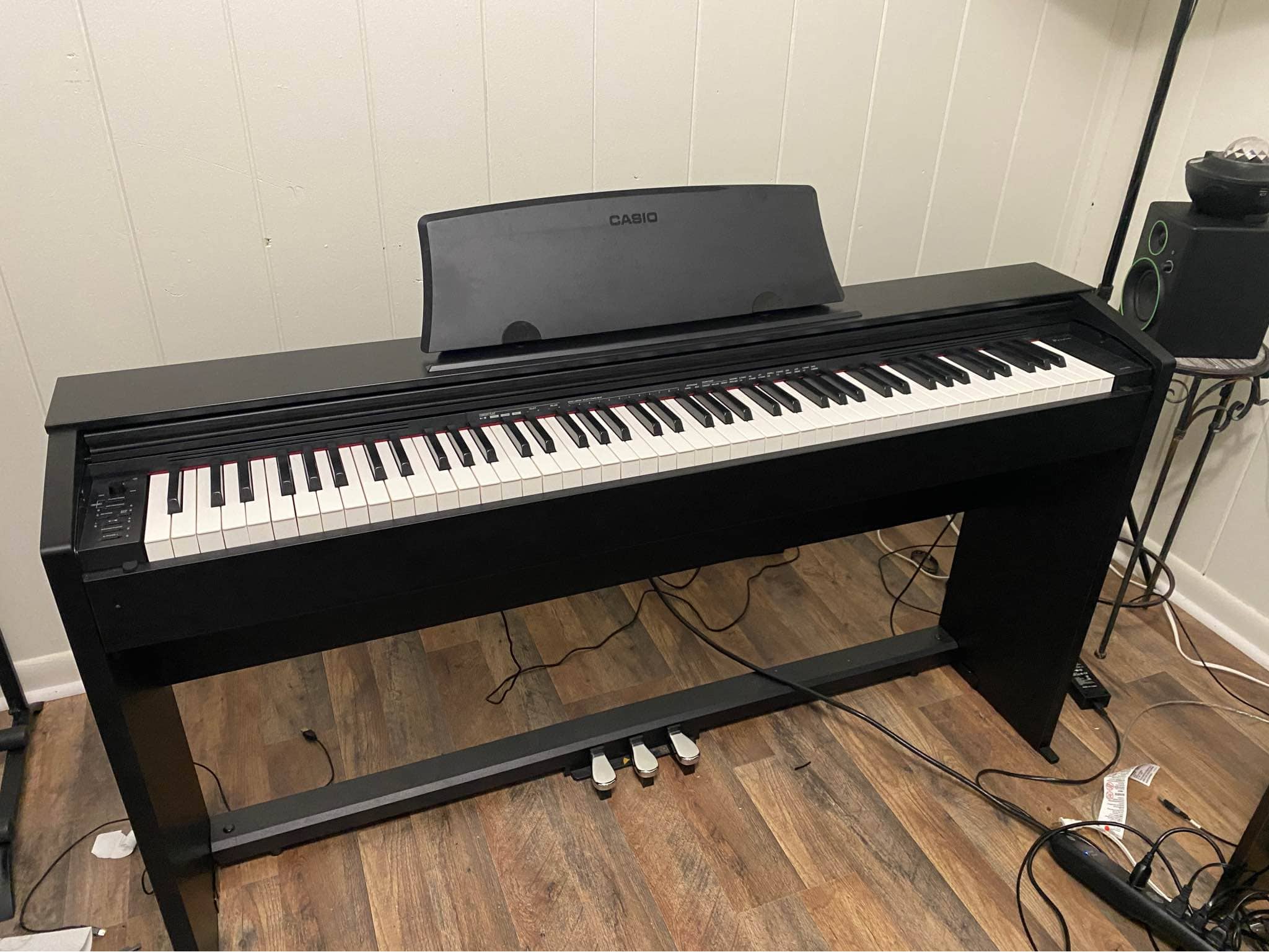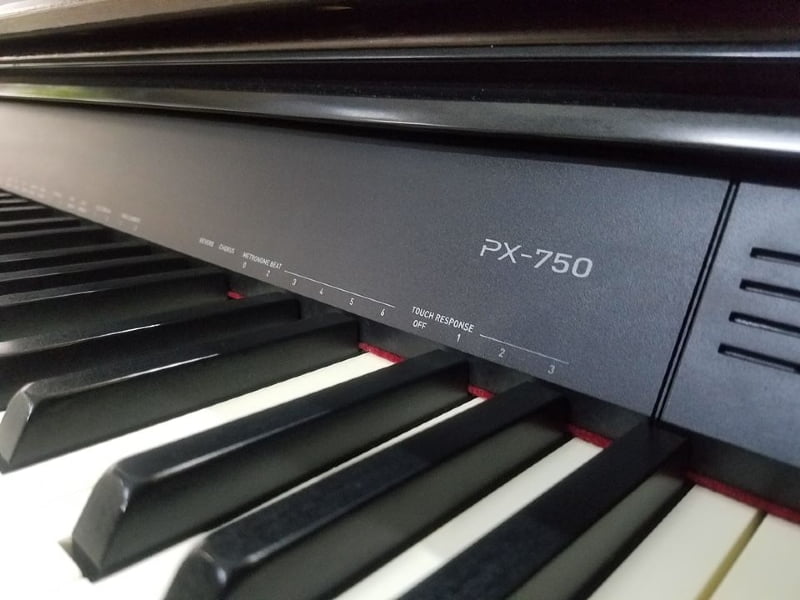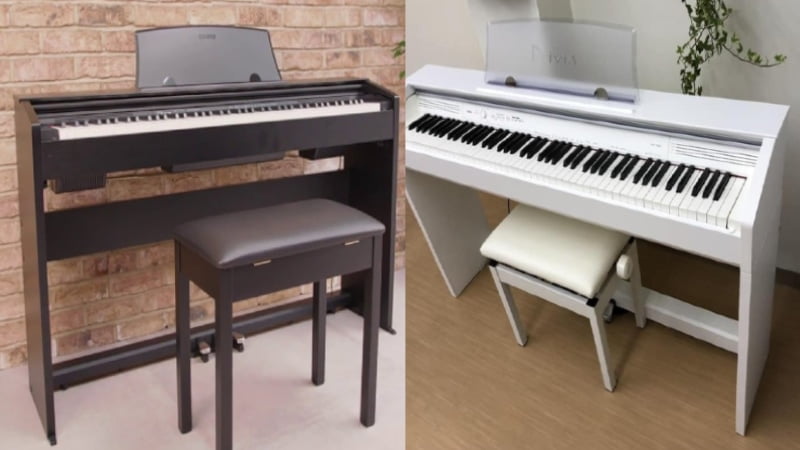Find out which Casio Privia model is the best pick for you in this Casio PX-770 vs 750 comparison.
Most people know that Casio’s Privia line contains some of the best console digital pianos on the market. But since the collection has so many options, it can be hard to choose one that fits your needs.
That’s why I decided to make this Casio PX-770 vs 750 comparison. These are two very similar pianos in the Privia collection that are in a similar price range, so comparing the two was really fun. But in the end, the newer Casio PX-770 won the comparison.
When testing out the pianos, I found that the Casio PX-770 sounded significantly better than the PX-750. They were basically tied in all aspects since the pianos felt similar and shared a lot of features. But since the PX-770 definitely had the better tone, it came out on top.
In this Casio PX-770 vs 750 review, I’ll explain how the PX-770 won out and the different features of each piano. That way, it’ll be much easier for you to find the best piano for your needs!
Casio PX-770 vs 750: Comparison Chart




Last update on 2025-04-15 / Affiliate links / Images from Amazon Product Advertising API
Casio PX-770 vs 750: A Head to Head Comparison
These pianos share many similarities, so to find a winner, I had to judge them based on three categories: tone, feel, and piano features. That way, I could create a scorecard and find the most objective winner possible.
By the end of this comparison, the score was 3-2 in favor of the Casio PX-770. It was a really close fight, with the PX-750 matching the PX-770 in almost every category. That said, the PX-770 is the more modern pick which makes the PX-750 seem dated, which is how it ended up winning.
Keep reading to dive into the details of this comparison and learn about the strengths and weaknesses of either piano.

Tone
The winner: PX-770
The one category where the PX-770 was the clear winner was the tone. I believe the tone is the most important feature of any digital piano, and if you’re looking for a model for your home, you need one that sounds as close to an acoustic piano as possible. Both of these pianos have decent speaker systems, but the PX-770 has a more modern tone generator and a wider sound library. So, it produces better tones while also having more versatility.
+Tone Generator
The Casio PX-750 is a fairly old model. Upon its release, it was one of the most modern digital pianos on the market. However, a lot of time has passed since then, which makes the piano feel a bit dated. And this couldn’t be clearer than when you look at the tone generator of the Casio PX-750.
This piano uses Multi-dimensional Morphing AiR, which is an old Casio tone engine. This generator aims to reproduce how sound waves travel through the air when you plan an acoustic piano. This made the piano sound much more realistic than its competitors at the time.
But Casio has since created a better tone generator at the same price.
This is the AiR sound source, which you can find on the PX-770. While this generator still relies on samples like the Multi-dimensional Morphing AiR, the samples are of much higher quality. This means you can expect much more clarity and brilliance when playing the PX-770.
When I conducted an ear test, it was clear as day that the AiR Sound Source was more realistic. So, if you need a piano that sounds as close to an acoustic piano as possible, the PX-770 is the better pick.
+Sound Library
Another reason the Casio PX-770 has a superior tone is its sound library. Both pianos have pretty decent sound libraries, which is nice considering they’re console digital pianos. These instruments are notorious for only having a small selection of tones, so it’s a nice change to see an 18-tone sound library on the PX-750 and a 19-tone sound library on the PX-770.
To be honest, this isn’t that much of a difference. However, the one extra tone on the Casio PX-770 makes it worth the upgrade. This is because the PX-770 features a stereo-sampled grand piano, which is missing on the PX-750.
If you want a large and grand piano tone, the Casio PX-770 has you covered. If the Casio PX-750 also had this voice, the pianos would have been tied in this category. But since the Casio PX-750 lacks a stereo-sampled grand piano, it lost out to the Casio PX-770.

Feel
The winner: Tie
One of the reasons the Casio PX-750 was so popular upon release was its realistic feel. This was large because of the sophisticated hammer action system on the piano. When upgrading the PX-750, Casio figured that they didn’t need to change this very realistic hammer action system, so you’ll find the same one on the Casio PX-770.
+Hammer Action
Both of these pianos feature the Tri-Scaled Hammer Action II system. This is a hammer action designed to replicate the feel of an acoustic piano. It does this by having slightly heavier keys on the lower keys that get lighter as you go up the piano. And compared to other pianos in their price range, the Casio Tri-Scaled Hammer Action performs very well.
These pianos can do this because of the Tri-Scaled Hammer action. The keys have a series of built-in sensors to detect how and when you press a key. That way, the piano plays the sample according to how you pressed the keys, creating a much more realistic feel.
Aside from the slight weight difference with the keys, these pianos also have great timing. I found that both pianos sound fairly realistic, and part of the reason for that is the slight delay from the time you hit the keys to the time you hear a note.
Piano Features
The winner: Tie
I expected the Casio PX-770 to come with more piano features since it’s an upgrade to the 750. However, that isn’t the case,slack as both pianos have great polyphony and various playing modes. So, they were also tied in this aspect, which is a testament to how the PX-750 can still compete with many modern digital pianos.
+Polyphony
I was very happy to see that both pianos have 128-note maximum polyphony. This is a great feature as it allows the piano to play up to 128 notes and sounds at the same time. This feature comes in handy when adding emotion to your playing with the sustain pedal or blending different voices with layering mode.
The high maximum polyphony on both of these pianos makes them very versatile. You can be as expressive as you want with these pianos, which is another reason why they are such great options.

+Playing Modes
These pianos have three playing modes – layer, duet, and split. These are all very useful for both beginners and advanced pianists. Duet is a mode designed for piano lessons as it divides the keyboard into two smaller pianos. This allows you and a piano instructor to play along simultaneously without needing two instruments.
Split mode divides the keyboard into two then you can assign different voices to each side. And with layering mode, you can blend two voices together to create a rich and unique tone. Casio didn’t need to add these features, but they did so to make the pianos more versatile and useful for the modern pianist.
Casio PX-770 vs 750: The Similarities
The Casio PX-770 is an upgrade to the 750, so you can expect them to share some similarities. For example, we already discussed that these two pianos share a hammer actions system. But did you know that they also have the same key texture? This is why I probably wouldn’t have been able to tell them apart if I had conducted a blind feel test.
Another similarity is that neither piano is portable. These are console digital pianos, so they are generally meant to stay in place. If you need a digital piano to bring with you to gigs and performances, these pianos may not be the right option for you.
Since the Casio PX-770 is an upgrade, it comes with more premium features than the 750 and easily won the comparison. But as you noticed, the PX-750 was able to hold its own against the modern upgrade fairly easily, which just shows the staying power of Casio pianos.
Quick Rundown of the Casio PX-770
- 88 scaled, weighted hammer-action keys with simulated ebony and ivory textures
- Stunning new piano sound with detailed resonance, plus 18 other Tones
- Stereo speaker system built into stylish, modern wooden cabinet
- Versatile practice, performance, and MIDI recording tools
- 3 year manufacturer extended warranty
Last update on 2025-04-15 / Affiliate links / Images from Amazon Product Advertising API
Quick Rundown of the Casio PX-750
- Tri-Sensor Scaled Hammer Action with Ebony and Ivory Keys
- Included matching stand with 3 pedals
- 18 Tones with Split / Layer Capability
- 128 Note Polyphony
- Class Compliant USB MIDI
Last update on 2025-04-15 / Affiliate links / Images from Amazon Product Advertising API
Product Video
Related Articles to Casio Px 770
- Casio PX-770 vs Korg B2SP: A Battle of Budget Console Digital Pianos?
- Casio PX-770 vs Kawai KDP-110: The Best Console Digital Pianos on a Budget?
- Casio PX-770 vs Kawai ES-110: Should You Get A Portable or Console Digital Piano?
- Casio PX-770 vs PX-160: Should You Get A Portable or Console Digital Piano?
- Casio PX-770 vs S1000: Should You Get A Portable or Console Digital Piano?
- Casio PX-770 vs PX-860: Should You Get A Portable or Console Digital Piano?
- Casio PX-770 Vs AP-270: Which Casio Model Wins Out?
- Casio PX-770 Vs 760: Which Is The Better Casio Privia Model?
- Casio PX-770 Vs Yamaha DGX-660: Should You Get A Portable Or Console Digital Piano?
- Casio PX-770 Vs Yamaha YDP-143: Which Is The Better Piano For The Money?
- Casio PX-770 Vs Roland FP-30: Should You Get A Portable or Console Digital Piano?
- Casio PX-770 vs Yamaha YDP-144: Which Is The Better Digital Piano?
- Casio PX-770 Vs 780: What’s The Difference Between These Two Digital Pianos?
- Casio PX-770 Vs 870: Which Casio Console Digital Piano Is Better?
- Yamaha P45 vs Casio PX 770: Should You Get the Portable or Console Digital Piano?
- Yamaha P125 vs Casio PX-770 Review: Why the Yamaha P125 Beats Out the Casio Console Digital Piano
References:
Lulacruza is an electronic folk duo operating at the junction of the hypermodern and the ancient. Our music weaves together hypnotic female singing, South American folk instruments and electronic processing, while channeling pulsating waves from the source of creation.
Lalucruza is also a community where you can connect with other music lovers to collaborate, exchange ideas and share knowledge. A platform for who wants to learns the basics of playing piano, guitar, drum masters’ technique, etc.. is the premise of our website.
